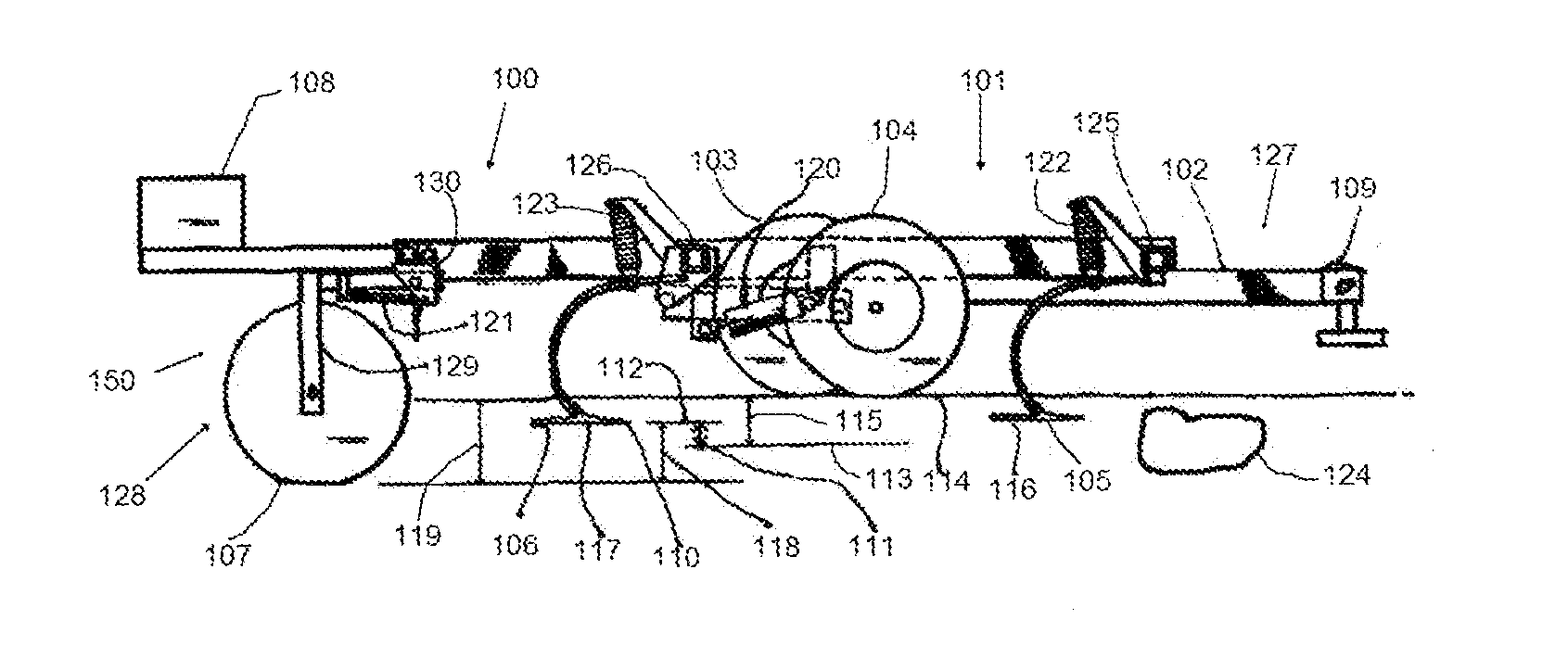Combined vertical and horizontal tillage with hardpan penetration
- Summary
- Abstract
- Description
- Claims
- Application Information
AI Technical Summary
Benefits of technology
Problems solved by technology
Method used
Image
Examples
first exemplary embodiment
Operation of First Exemplary Embodiment
[0017]The preferred exemplary embodiment is implement 100 shown in FIG. 1 and FIG. 2. Implement 100 uses a colter 107 to break up the typical compaction layer or hard pan 111 that extends downwardly from the level 112 of a bottom 116 of front sweep 105 and a bottom 117 of rear sweep 106 down several inches to a level 113 which lies at a distance 115 of typically about 4-6 inches below the surface 114 of the ground. Front sweep 105 and rear sweep 106 are quite effective at slicing, breaking apart and lifting up the upper several inches of soil and cutting weeds off at their roots. However, front sweep 105 and rear sweep 106 tend to produce a compaction layer or “hardpan”111 due to the downward pressure on the underlying soil as the front sweep 105 and rear sweep 106 each lifts up the upper layer of soil. Hardpan 111 is a problem for deep-rooted crops such as corn, which have a natural route depth of about 5 to 8 feet. Corn roots have difficulty ...
second exemplary embodiment
Operation of Second Exemplary Embodiment
[0021]The operation of implement 300 will be readily apparent to any farmer of ordinary experience and skill from the description above. It is to be noted that a colter 303 of this diameter is highly unusual and nonobvious, as is a bladed colter 403. It will be quite a sight to see such massive colters as colters 107 moving across the farm field throwing dirt. Likewise it will be impressive for a farmer to see the high speed at which colters 403 can be run across a field, since the blades 304,305,306,307,308,309,310,311,501-511 offer less resistance to travel than typical horizontal sweeps or plows. Colter 303 will roll along the field penetrating hardpan 111 and tilling the soil. Once these massive colters 107 pass over a field, the hardpan should be effectively gone entirely if the colters 107 overlap. Implements 300 and 400 use overlapping colters 107 so that the entire hardpan is destroyed and the planting tractor could plant the field in ...
PUM
 Login to View More
Login to View More Abstract
Description
Claims
Application Information
 Login to View More
Login to View More - R&D
- Intellectual Property
- Life Sciences
- Materials
- Tech Scout
- Unparalleled Data Quality
- Higher Quality Content
- 60% Fewer Hallucinations
Browse by: Latest US Patents, China's latest patents, Technical Efficacy Thesaurus, Application Domain, Technology Topic, Popular Technical Reports.
© 2025 PatSnap. All rights reserved.Legal|Privacy policy|Modern Slavery Act Transparency Statement|Sitemap|About US| Contact US: help@patsnap.com



